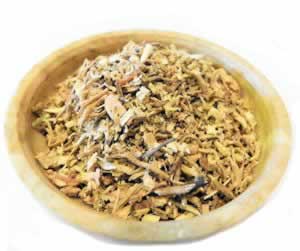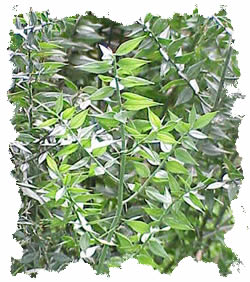Broom, Butcher's Ruscus aculeatus

Broom chopped root
- Common Names
- Butcher's Broom , Jew's Myrtle, Sweet Broom, Scotch Broom
- Botanical Name
- Ruscus aculeatus
- Family
- LILIACEAE
Medicinal Uses & Benefits of Butcher's Broom
![]() How to Use|
Side Effects |
Plant & Garden|
How to Use|
Side Effects |
Plant & Garden|
- Medicinal Uses: * Cardiovascular
* Cellulite
* Varicose Veins
- Properties: * Circulation * Diaphoretic * Diuretic * Laxative
- Parts Used: rhizome, aerial parts
- Constituents: ascorbic-acid, beta-carotene, calcium, chromium , chrysophanic-acid , cobalt, fiber, glycolic-acid, iron magnesium, manganese, mucilage, niacin, phosphorus, potassium riboflavin, ruscogenin, rutin, selenium thiamin
How to Use: Broom, Butcher's
Butchers Broom has a long history of use in herbal medicine traditions as a diuretic and blood vessel toner. Herbal extracts from the roots of the Broom plant seem to have the ability to strengthen and tone blood vessels. Broom is approved by the authoritative German Commission E for chronic venous insufficiency, a condition causing pain, swelling, and fatigue in the calves that is related to varicose veins, and hemorrhoids. Broom may be a good herbal remedy for those who suffer from restless leg syndrome based on its medicinal properties.
Herbalists also use this potent plant in the treatment of poor circulation, irregular heart rhythm, and other related heart problems. Broom is known for it's cleansing and diuretic properties, which makes it useful for treating bladder infections and reducing cellulite. Drinking broom root tea on a consistent basis can also help with chronic dark circles under the eyes.
Preparation Methods & Dosage :Tea or extract. To make a tea from chopped root, place 1 teaspoon of the herb in a cup of boiling water and allow to steep in a closed teapot for 10 minutes.
Broom, Butcher's Remedies
Broom, Butcher's Side Effects: Should be used with caution in pregnant women and young children and those with kidney and/or liver disorders.
Plant Description
- Flowers:Leaflike branches end in a terminal spine, with greenish-white flowers
- Plant type: Shrubby, evergreen bush, low growing, up to 3 feet high
- Leaves: . The young shoots of Butcher's Broom can be eaten like those of Asparagus, a plant to which it is closely allied. The matured branches used to be bound into bundles and sold to butchers for sweeping the blocks, hence the name.
- Fruit: Shiny red berries
- Preferred Habitat: very hardy, thriving in almost any soil or situation
- Harvest Season:Both the aerial (aboveground) parts and the root of the plant are gathered in summer when the herb is in bloom. The whole plant is used in herbal medicine
- Distribution:
Regional Traditions :European *
Related Species The primary phytochemical in the similarly named Scotch broom Cytisus scoparius is sparteine, a cardiac depressant - use with great caution.
History and Traditions & Folklore
Until the twentieth century, the dried plant was used as a broom throughout Europe, hence the common name butchers broom It is a plant of Mars, being of a gallant cleansing and opening quality: the decoction of the roots, made with wine, openeth obstructions, provoketh urine, helpeth to expel gravel, and the stone, the stranguary, and women's courses, as also the yellow jaundice, and the head-ach
It is a plant of Mars, being of a gallant cleansing and opening quality: the decoction of the roots, made with wine, openeth obstructions, provoketh urine, helpeth to expel gravel, and the stone, the stranguary, and women's courses, as also the yellow jaundice, and the head-ach
Nicholas Culpeper, 1653
- The American Botanical Council, German Commission E: The German Commission E is rather like an FDA of herbs, and is one of the most respected world organizations in the field of for herbal drugs and preparations from medicinal plants. It was established in by the Minister of Health in Germany in 1978. HerbalGram












